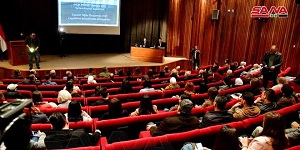The historical spring of Afqa in the city of Palmyra, whose rehabilitation was completed last February and is estimated to be 6000 years old, has been the focus of the symposium and exhibition held by the Russian Cultural Center in Damascus in cooperation with the Assad National Library.
The event included the screening of an 11-minute short film that also included a talk about the importance of the historic city of Palmyra and its great monuments, in addition to the importance of the project to rehabilitate the Afqa spring for the life of Palmyra and its oases and to promote the tourism movement in the city.
Director of the Voluntary Expeditionary Archaeological Corps in Russia, Timur Karmov, pointed out in a lecture he gave, the importance of the project to restore the archaeological spring of Afqa, which took about three months to implement, stressing the importance of cultural and historical cooperation between the two countries in light of the Russian side’s interest in reconstruction, especially the monuments that were destroyed by terrorists. .
Karmov highlighted the difficulties represented in isolating the river’s stream from the rubble and landfills, exposing the entire main staircase leading to the spring’s stream, and rebuilding the archaeological wall using stones similar to the old ones.
Director of the Russian Cultural Center in Damascus Nikolai Sokhov pointed out the importance of this event in shedding light on the most important archaeological sites in the city of Palmyra, noting the cultural cooperation between his country and Syrian institutions regarding history and antiquities and their restoration, as there are many joint projects between the two sides, especially with regard to Palmyra.
The symposium included a photo exhibition entitled “Palmyra in Russian Eyes”, which included more than 40 photographs that showed the historical Afqa spring before and after the restoration as the photographer of the exhibition, the Russian artist Alona Zaitsava, stated that she took hundreds of photos during her visit to the city several times with the joint Russian-Syrian mission that carried out the restoration process with the aim of informing the Syrians and the world about the importance of this city in history and how it is now. The Russian artist hopes to photograph all the archaeological sites in Syria and wishes that all Syrian heritage sites return to their splendor and rise again.
Deputy Director of the Directorate of Antiquities and Museums, Director of Excavations and Archaeological Studies, Dr. Hammam Sharif Saad, drew attention to the importance of the project carried out by the Russian side, in cooperation with the Directorate of Antiquities, to revitalize Afqa spring and help the city’s residents return to it, indicating that this project is the first work accomplished in the city following the return of security and safety to Palmyra.

